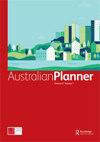Meeting the need for a rational basis for open space and recreation planning in new high density residential areas: the Recreational Activity Benchmark model
IF 1.5
Q2 Social Sciences
引用次数: 1
Abstract
ABSTRACT The development of new high-density residential precincts in Australian cities, notably in association with new public transport nodes (Transit-Oriented Developments – TODs), presents challenges for planners in creating living environments, including provision for open space and recreation. The traditional ‘standards’ method and other existing approaches to planning for open space and recreation have significant limitations in coping with the challenges presented by high-density developments. It is argued in this paper that a planning approach focused on recreation participation as the key performance criterion can provide a solution. The Recreational Activity Benchmark (RAB) model is presented and shown to be capable of providing for appropriate levels of recreational activity while making savings in land requirements.为新建高密度住宅区的休憩空间及康乐规划提供合理基础:康乐及康乐活动基准模式
摘要澳大利亚城市中新的高密度住宅区的开发,尤其是与新的公共交通节点(面向交通的开发——TODs)相关的开发,给规划者创造生活环境(包括提供开放空间和娱乐)带来了挑战。传统的“标准”方法和其他现有的开放空间和娱乐规划方法在应对高密度开发带来的挑战方面有很大的局限性。本文认为,以娱乐参与为关键绩效标准的规划方法可以提供解决方案。提出并证明了娱乐活动基准(RAB)模型能够提供适当水平的娱乐活动,同时节省土地需求。
本文章由计算机程序翻译,如有差异,请以英文原文为准。
求助全文
约1分钟内获得全文
求助全文

 求助内容:
求助内容: 应助结果提醒方式:
应助结果提醒方式:


